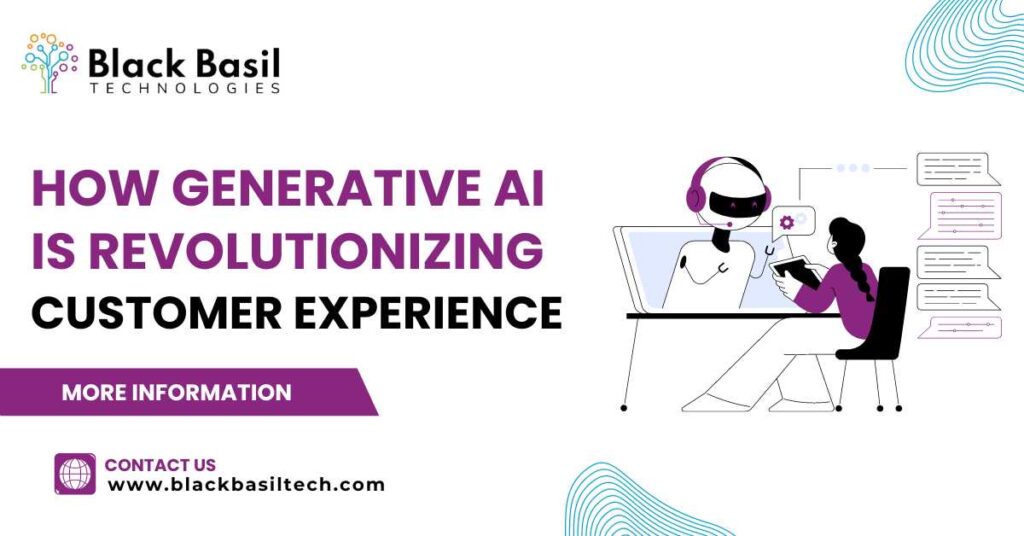
Introduction:
In today’s competitive business landscape, delivering exceptional customer experiences has become a top priority for brands. And one technology that is driving a significant revolution in this field is generative AI. By leveraging the power of machine learning and natural language processing, generative AI is transforming the way companies interact with their customers, offering hyper-personalized and seamless experiences like never before. With the ability to understand and respond to customer queries and concerns in real-time, generative AI enables brands to provide instant solutions while reducing human effort. By analyzing customer data, preferences, and behaviors, this groundbreaking technology empowers businesses to offer highly relevant and targeted recommendations. Moreover, generative AI enables brands to automate and personalize customer engagement at scale, making each interaction feel tailored and unique. From chatbots that provide instant support to virtual assistants that anticipate customer needs, the possibilities with generative AI are endless. In this article, we delve into the transformative power of generative AI in revolutionizing customer experience. Join us as we explore this cutting-edge approach to customer interaction and discover how it can amplify your brand’s customer experience strategy.The Impact of AI on Modern Customer Service
In today’s competitive business landscape, delivering exceptional customer experiences has become a top priority for brands. And one technology that is driving a significant revolution in this field is generative AI. By leveraging the power of machine learning and natural language processing, generative AI is transforming the way companies interact with their customers, offering hyper-personalized and seamless experiences like never before.
With the ability to understand and respond to customer queries and concerns in real-time, generative AI enables brands to provide instant solutions while reducing human effort. By analyzing customer data, preferences, and behaviors, this groundbreaking technology empowers businesses to offer highly relevant and targeted recommendations.Moreover, generative AI enables brands to automate and personalize customer engagement at scale, making each interaction feel tailored and unique. From chatbots that provide instant support to virtual assistants that anticipate customer needs, the possibilities with generative AI are endless.
In this article, we delve into the transformative power of generative AI in revolutionizing customer experience. Join us as we explore this cutting-edge approach to customer interaction and discover how it can amplify your brand’s customer experience strategy.

Understanding customer experience
Customer experience (CX) refers to the overall impression and perception that a customer has of a brand or company based on their interactions and touchpoints. It encompasses every aspect of the customer’s journey, from initial awareness and research to purchase, use, and post-purchase support. A positive customer experience can lead to increased customer loyalty, higher satisfaction, and improved brand reputation, ultimately driving business growth and profitability. This requires a deep understanding of customer behavior, preferences, pain points, and the factors that influence their decision-making process. By analyzing customer data, gathering feedback, and continuously optimizing the customer journey, businesses can create tailored experiences that resonate with their target audience and set them apart from the competition. Effective customer experience management involves a holistic approach that considers the entire customer lifecycle, from initial engagement to post-purchase support. This includes streamlining communication channels, providing personalized recommendations, offering seamless omnichannel experiences, and ensuring prompt and efficient issue resolution. By delivering consistently positive experiences, businesses can foster strong customer relationships, increase customer lifetime value, and drive long-term business success.Leveraging AI to Improve Customer Satisfaction
Artificial Intelligence (AI) has emerged as a powerful tool in transforming customer experience. By leveraging advanced technologies such as machine learning, natural language processing, and predictive analytics, AI-powered solutions are enabling businesses to better understand, anticipate, and respond to customer needs and preferences. Beyond chatbots, AI is also enabling businesses to personalize the customer journey at scale. By analyzing customer data, AI can identify patterns, segment customers, and deliver highly targeted and relevant content, products, and services.
Benefits of generative AI in customer experience
How AI is Revolutionizing Customer Engagement Across Industries
Challenges and limitations of generative AI in customer experience
While the benefits of generative AI in customer experience are undeniable, there are also some challenges and limitations that businesses must consider when implementing this technology.
One of the primary concerns is the potential for bias and inaccuracy in the AI-generated responses. Generative AI models are trained on large datasets, which may contain inherent biases or inconsistencies. This can lead to the generation of responses that are not fully accurate or representative of the customer’s needs, potentially undermining the customer experience. Businesses must invest in robust data curation and model validation processes to mitigate these risks.Another challenge is the need for seamless integration between generative AI and existing customer experience systems and processes. Effective implementation requires careful coordination and alignment across various touchpoints, ensuring a consistent and cohesive customer experience. This can be particularly challenging for large organizations with complex technology infrastructures and legacy systems.

Implementing generative AI in your customer experience strategy
- Assess your customer experience needs: Thoroughly analyze your customer data, pain points, and the areas where generative AI can have the most significant impact. Identify the specific use cases and customer touchpoints where this technology can be most effectively deployed.
- Evaluate your data and infrastructure: Ensure that your customer data is clean, accurate, and accessible to the generative AI models. Additionally, assess the compatibility of your existing systems and infrastructure with the integration of generative AI-powered solutions.
- Develop a roadmap and implementation plan: Create a comprehensive roadmap that outlines the timeline, resources, and milestones for implementing generative AI in your customer experience strategy. Establish clear objectives, KPIs, and a phased rollout approach to ensure a smooth and successful implementation.
- Prioritize user experience and transparency: Design the customer-facing interfaces and interactions with a focus on user-friendliness, intuitive navigation, and clear communication about the role of generative AI. Maintain transparency about the capabilities and limitations of the AI-powered solutions to build trust and manage customer expectations.
- Continuously monitor and optimize: Regularly monitor the performance and impact of your generative AI-powered customer experience initiatives. Collect feedback, analyze customer behavior, and make iterative improvements to ensure the solutions are delivering the desired outcomes and enhancing the overall customer experience.
- Upskill your team: Invest in training and development for your customer experience and IT teams to ensure they have the necessary skills and knowledge to effectively leverage generative AI technologies. Encourage a culture of innovation and continuous learning to stay ahead of the curve.
Best practices for using generative AI in customer experience
- Personalization at scale: Leverage the power of generative AI to deliver highly personalized experiences at scale, tailoring content, recommendations, and interactions to individual customer preferences and behaviors.
- Seamless integration: Ensure a seamless integration of generative AI-powered solutions with your existing customer experience infrastructure, ensuring a cohesive and consistent experience across all touchpoints.
- Ethical and responsible AI: Prioritize ethical and responsible AI practices, including transparency, data privacy, and the mitigation of biases and inaccuracies in the AI-generated outputs.
- Continuous learning and improvement: Implement robust feedback loops and performance monitoring mechanisms to continuously learn from customer interactions and optimize the generative AI-powered solutions over time.
- Human-in-the-loop: Maintain a balance between AI-powered automation and human intervention, leveraging the strengths of both to deliver the most effective and empathetic customer experience.
- Proactive customer education: Educate customers about the role of generative AI in their interactions, setting clear expectations and fostering trust in the technology.
- Collaboration and cross-functional alignment: Foster collaboration between customer experience, IT, and data teams to ensure a cohesive and strategic approach to implementing generative AI in customer experience initiatives.
What’s Next for Generative AI in Customer Service?
- Multimodal interactions: The integration of generative AI with other technologies, such as computer vision and speech recognition, will enable more natural and seamless multimodal interactions, allowing customers to engage with brands using a combination of text, voice, and visual inputs.
- Hyper-personalization: Advancements in predictive analytics and generative AI will enable businesses to deliver truly personalized experiences, with AI-generated content, recommendations, and even product designs tailored to individual customer preferences and behaviors.

- Conversational commerce: The convergence of e-commerce and conversational AI will lead to the rise of “conversational commerce,” where customers can seamlessly browse, explore, and purchase products through natural language interactions with AI-powered virtual assistants.
- Empathetic and emotional AI: Generative AI models will continue to evolve, becoming more adept at understanding and responding to the emotional and psychological aspects of customer interactions, creating more empathetic and human-like customer experiences.
- Autonomous decision-making: As generative AI systems become more advanced, they will be able to make autonomous decisions and take actions on behalf of customers, further streamlining and enhancing the customer experience.
- Ethical and responsible AI governance: As the adoption of generative AI in customer experience grows, there will be an increased focus on developing robust ethical and governance frameworks to ensure the responsible and transparent use of this technology.



Leave a Reply